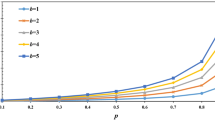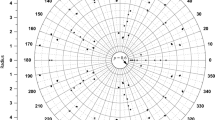Abstract
With the evolution of internet, there has been increased interest in the use of computer-communication networks and digital communication systems. But unusual events, like virus attack, that often results in abrupt change in the state of the system poses a major threat to these systems. The occurrence of a virus may cause immediate removal of some elements (packets) from the system. Such type of situations can be well represented as discrete-time catastrophe model where interruptions due to various types of virus attacks are referred to as catastrophe. In this paper we study a discrete-time catastrophe model in which population grows according to batch Bernoulli process and catastrophes occur according to discrete-time renewal process. When a catastrophe occurs, an element (individual or packet) of the population survives with probability p or dies with probability \(1-p\). The analysis of the model has been done using supplementary variable technique and steady-state probability generating function of the distribution of population size at post-catastrophe, arbitrary and pre-catastrophe epochs are obtained under late arrival system with delayed access. In order to make the model more useful for practitioners, a step-wise computing process for evaluation of distribution of population size at various epochs for commonly used inter-catastrophe time distributions viz. geometric, deterministic and arbitrary are given. We also present recursive formulae to compute factorial moments of the population size at various epochs. Further to study the effect of critical model parameters, numerical results and some graphs are included.







Similar content being viewed by others
References
Adan, I., Economou, A., & Kapodistria, S. (2009). Synchronized reneging in queueing systems with vacations. Queueing Systems, 62(1–2), 1–33.
Alfa, A. S. (2010). Queueing theory for telecommunications: Discrete time modelling of a single node system. Berlin: Springer.
Alfa, A. S. (2016). Applied discrete-time queues. Berlin: Springer.
Artalejo, J. R., Economou, A., & Lopez-Herrero, M. (2007). Evaluating growth measures in an immigration process subject to binomial and geometric catastrophes. Mathematical Biosciences and Engineering: MBE, 4(4), 573–594.
Atencia, I., & Moreno, P. (2004). The discrete-time \({Geo/Geo/1}\) queue with negative customers and disasters. Computers & Operations Research, 31(9), 1537–1548.
Baumann, H., & Sandmann, W. (2012). Steady state analysis of level dependent quasi-birth-and-death processes with catastrophes. Computers & Operations Research, 39(2), 413–423.
Boudali, O., & Economou, A. (2012). Optimal and equilibrium balking strategies in the single server Markovian queue with catastrophes. European Journal of Operational Research, 218(3), 708–715.
Bruneel, H., & Kim, B. G. (1993). Discrete-time models for communication systems including ATM. Boston: Kluwer Acadmic.
Bruneel, H., Walraevens, J., Claeys, D., & Wittevrongel, S. (2012). Analysis of a discrete-time queue with geometrically distributed service capacities. In K. Al-Begain, D. Fiems, & J. M. Vincent (Eds.), Analytical and stochastic modeling techniques and applications (pp. 121–135). Berlin: Springer.
Bruneel, H., Wittevrongel, S., Claeys, D., & Walraevens, J. (2016). Discrete-time queues with variable service capacity: A basic model and its analysis. Annals of Operations Research, 239(2), 359–380.
Chaudhry, M. L. (2000). On numerical computations of some discrete-time queues. In W. K. Grassmann (Ed.), Computational Probability (pp. 365–408). Berlin: Springer.
Chaudhry, M. L., Gupta, U. C., & Templeton, J. G. C. (1996). On the relations among the distributions at different epochs for discrete-time \({GI/Geom/1}\) queues. Operations Research Letters, 18(5), 247–255.
Chen, A., Zhang, H., Liu, K., & Rennolls, K. (2004). Birth-death processes with disaster and instantaneous resurrection. Advances in Applied Probability, 36(1), 267–292.
Claeys, D., Steyaert, B., Walraevens, J., Laevens, K., & Bruneel, H. (2013). Analysis of a versatile batch-service queueing model with correlation in the arrival process. Performance Evaluation, 70(4), 300–316.
Dabrowski, C. (2015). Catastrophic event phenomena in communication networks: A survey. Computer Science Review, 18, 10–45.
De Muynck, M., Wittevrongel, S., & Bruneel, H. (2017). Analysis of discrete-time queues with general service demands and finite-support service capacities. Annals of Operations Research, 252(1), 3–28.
Economou, A. (2003). On the control of a compound immigration process through total catastrophes. European Journal of Operational Research, 147(3), 522–529.
Economou, A. (2004). The compound Poisson immigration process subject to binomial catastrophes. Journal of Applied Probability, 41(2), 508–523.
Economou, A., & Fakinos, D. (2003). A continuous-time Markov chain under the influence of a regulating point process and applications in stochastic models with catastrophes. European Journal of Operational Research, 149(3), 625–640.
Economou, A., & Fakinos, D. (2008). Alternative approaches for the transient analysis of Markov chains with catastrophes. Journal of Statistical Theory and Practice, 2(2), 183–197.
Economou, A., Kapodistria, S., & Resing, J. (2010). The single server queue with synchronized services. Stochastic Models, 26(4), 617–648.
Gupta, U., Samanta, S. K., Sharma, R., & Chaudhry, M. (2007). Discrete-time single-server finite-buffer queues under discrete Markovian arrival process with vacations. Performance Evaluation, 64(1), 1–19.
Hunter, J. J. (2014). Mathematical techniques of applied probability: Discrete time models: Basic theory (Vol. 1). Cambridge: Academic Press.
Jeyakumar, S., & Gunasekaran, P. (2017). An analysis of discrete queue with disaster and single vacation. International Journal of Pure and Applied Mathematics, 113(6), 82–90.
Kapodistria, S., Phung-Duc, T., & Resing, J. (2016). Linear birth/immigration-death process with binomial catastrophes. Probability in the Engineering and Informational Sciences, 30(1), 79–111.
Knopp, K. (1951). Theory and application of infinite series. New York: Dover Publications.
Park, H. M., Yang, W. S., & Chae, K. C. (2009). Analysis of the \({GI/Geo/1}\) queue with disasters. Stochastic Analysis and Applications, 28(1), 44–53.
Samanta, S. K., Gupta, U., & Sharma, R. (2007). Analyzing discrete-time \({D-BMAP/G/1/N}\) queue with single and multiple vacations. European Journal of Operational Research, 182(1), 321–339.
Takagi, H. (1993). Queuing analysis: A foundation of performance evaluation. Discrete time systems (Vol. 3). Amsterdam: North-Holland.
Woodward, M. E. (1994). Communication and computer networks: Modelling with discrete-time queues. Los Alamitos: Wiley-IEEE Computer Society Pr.
Yajima, M., & Phung-Duc, T. (2019). A central limit theorem for a Markov-modulated infinite-server queue with batch Poisson arrivals and binomial catastrophes. Performance Evaluation, 129, 2–14.
Yi, X. W., Kim, J. D., Choi, D. W., & Chae, K. C. (2007). The \({Geo/G/1}\) queue with disasters and multiple working vacations. Stochastic Models, 23(4), 537–549.
Acknowledgements
The first author Nitin Kumar is thankful to Indian Institute of Technology Kharagpur, India for the financial support. The authors wish to thank the editor and anonymous referee for their valuable comments and suggestions which led to the paper in the current form.
Author information
Authors and Affiliations
Corresponding author
Additional information
Publisher's Note
Springer Nature remains neutral with regard to jurisdictional claims in published maps and institutional affiliations.
Appendices
Appendix 1: Evaluation of A(s)
where \(\{g_n\}^{k*}\) is the kth order convolution of \(g_n\).
Multiplying the above expression by \(s^n\) and summing over the range of n from 0 to \(\infty \), we get
Appendix 2: Evaluation of \(A_e(s)\)
Multiplying the above expression by \(s^n\) and summing over the range of n from 0 to \(\infty \), we get
Appendix 3: Convergence of infinite product
We prove the convergence of infinite product appearing in (21). Using a comparison argument, it is clear that the infinite product \(\prod \nolimits _{k=1}^{\infty }A(1-p^k+p^ks)\) converges, when \( |s| \le 1 \), if the product \(\prod \nolimits _{k=1}^{\infty }A(1-p^k)\) converges (see Economou 2004).
In order to prove the above result, we use following theorem:
Theorem 3
If, for every k, \(a_k \ge 0\), then the product \(\prod \nolimits _{k=1}^{\infty }(1-a_k)\) is also convergent iff \(\sum \nolimits _{k=1}^{\infty } a_k\) converges [see Theorem 4, pg. 220 Knopp (1951)].
Now using the above theorem and considering \(a_k=1-A(1-p^k)\), it is sufficient to prove that
We know that every pgf \(C(s)=\sum \nolimits _{n=0}^{\infty }c_n s^n,~~ |s| \le 1\), can be written as
Setting \(C(s)=A(s)\) and \(s=1-p^k\) in (59), we get
where \({a}=a_{(1)}= b \lambda {\bar{g}} \) is the mean number of arrivals between two consecutive catastrophes. Now we have
Hence the infinite product converges.
Rights and permissions
About this article
Cite this article
Kumar, N., Gupta, U.C. Analysis of batch Bernoulli process subject to discrete-time renewal generated binomial catastrophes. Ann Oper Res 287, 257–283 (2020). https://doi.org/10.1007/s10479-019-03410-z
Published:
Issue Date:
DOI: https://doi.org/10.1007/s10479-019-03410-z




